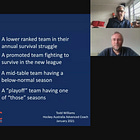It's Money Time and You Just Lost the Ball
Dealing with a Loss of Ball Against a Full Press in the Final Minutes of a Game. Let's Talk Strategies for Both Scenarios and How To Train for these.
The final minutes of a game are often where matches are won or lost. The stakes are high, emotions are running wild, and every decision on the pitch becomes magnified. When facing a full press after losing possession, the tactical response can vary significantly depending on whether you're ahead by one goal or chasing the game.
Let’s break this down into actionable strategies for both scenarios, drawing on insights from some of the best minds in hockey coaching.
Two Scenarios
Scenario 1: You're Ahead by One Goal
When you're leading, the priority is clear: protect your advantage. But this doesn’t mean simply parking the bus and hoping for the best. As Todd Williams once emphasized in a masterclass on relegation battles:
The stats are always in favor of the defense. Even the best attacks are usually one in three.
This means that if you stay disciplined and organized, the odds are in your favor .
Key Principles to Defend Against a Full Press
Compactness is King
Raoul Ehren, during an AMA session, highlighted the importance of staying close together in any press situation. “No matter what press you play, it’s the intensity and how close you are together that matters” . When facing a full press, your team must remain compact, especially in the central channels. This denies the opposition easy access to dangerous areas and forces them to play around you rather than through you.Immediate Pressure on the Ball
The player who loses the ball must react instantly to apply pressure. This is a principle echoed by both Andreu Enrich and Adam Commens. The goal is to deny the opponent a clean first pass, which often sets the tone for their press. Surrounding players should close off passing lanes, particularly vertical options, and shrink the pitch centrally .Controlled Clearances
When under pressure, it’s tempting to simply smash the ball upfield. However, this often results in giving possession straight back to the opposition. Instead, aim for controlled clearances into wide areas where your team can regroup and reset defensively.Use the Sidelines
Andreu Enrich once pointed out the value of guiding opponents towards the sidelines during a press. “When the threat comes from the outside, it forces the player to turn inside, where your team is better positioned to regain possession” . This principle can be applied defensively to funnel the opposition into less dangerous areas.Time Management
Let’s not forget the clock. If you’re ahead, every second counts. Encourage your players to take their time on set pieces, make smart fouls when necessary, and generally disrupt the rhythm of the game. This isn’t about unsportsmanlike conduct but rather about managing the game intelligently.
Scenario 2: You're Down by One Goal
When you’re chasing the game, the approach shifts dramatically. Now, the focus is on regaining possession quickly and creating scoring opportunities. As Danny Kerry once said:
Even when we don’t have the ball, we’re trying to move from a deny mode to an attacking mindset.
This attacking mindset is crucial in the dying minutes of a match.
Key Principles to Break a Full Press
Quick and Accurate
Passing Speed and precision are non-negotiable. As I’ve often said in coaching sessions, “Speed to space, precision in our passing” is the foundation of breaking down a press . Players must be confident and decisive in their passing to avoid turnovers in dangerous areas.Overload Key Areas
Raoul Ehren’s concept of pressing with four players can be flipped offensively. By overloading specific areas of the pitch, you can create numerical advantages that make it easier to bypass the press . This requires excellent communication and coordination among your players.Stretch the Opposition
Use the full width of the pitch to stretch the opposition’s press. This creates gaps that can be exploited with quick switches of play. Encourage your players to stay wide and provide options for the ball carrier.Risk vs. Reward
In the final minutes, you may need to take calculated risks. This could mean committing more players forward or attempting riskier passes to penetrate the press. As Todd Williams noted, “Develop the mentality of working unbelievably hard to get pressure on the ball and stop an attack” . The same mentality applies offensively: work hard to create opportunities, even if it means leaving yourself slightly exposed at the back.Set Plays as a Weapon
If you win a free hit or penalty corner, make it count. These are golden opportunities to level the score, so ensure your team is well-drilled in set-piece scenarios.
To sum up…
Whether you’re ahead or behind, dealing with a full press in the final minutes of a game is a test of your team’s discipline, decision-making, and mental toughness. As Adam Commens once said:
Trust is central. Trust in the process, trust in your teammates, and trust in your ability to execute under pressure.
By instilling these principles in your players, you can give them the tools they need to succeed in these high-stakes moments.
Before we talk about training it, these were some of the sources for the above thoughts:
Training for These Scenarios
We explored strategies for dealing with a loss of ball against a full press in the final minutes of a game, whether you're ahead by one goal or chasing the match. Now, let’s dive deeper into how to train for these moments. The key here is not just about replicating the chaos of a match but embedding the principles that underpin effective decision-making and execution under pressure. As Raoul Ehren once said during an AMA session:
You don’t train for the chaos by just creating chaos. You train the principles that allow players to thrive in chaos.
Preparation is everything. As coaches, we must create training environments that simulate the chaos and pressure of these moments. Here are some ideas:












